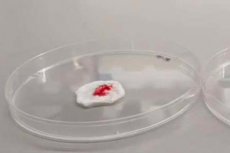New publications
Biosynthetic material based on bacterial cellulose provides accelerated healing of burn wounds
Last reviewed: 03.08.2025

All iLive content is medically reviewed or fact checked to ensure as much factual accuracy as possible.
We have strict sourcing guidelines and only link to reputable media sites, academic research institutions and, whenever possible, medically peer reviewed studies. Note that the numbers in parentheses ([1], [2], etc.) are clickable links to these studies.
If you feel that any of our content is inaccurate, out-of-date, or otherwise questionable, please select it and press Ctrl + Enter.

Scientists from the Shenzhen Advanced Institutes of Science and Technology (CAS) together with colleagues from Shanghai Jiaotong Medical University have developed an innovative hemostatic dressing material based on bacterial cellulose (BC) enhanced with thrombin. The results of the study were published in the journal Advanced Materials.
Problem
When treating burn wounds and other serious injuries, it is important to stop bleeding quickly, but traditional electrocoagulation can damage tissue and requires specialized equipment.
Solution
A team led by Drs Zhong Chao and An Bolin attached human thrombin to a nanoporous bacterial cellulose structure via a specially engineered cellulose-binding domain (CBD). The resulting T-BC composite combines:
- High biocompatibility and breathability BC,
- Sustained retention and local release of thrombin,
- No toxic reagents used in production (simple soaking in a soft protein solution).
Results
- Rat liver transection model: bleeding control in ≤1 minute, significantly faster than standard materials.
- Model of deep second-degree burn: on the fifth day, wound healing was 40% faster compared to the control.
- Genetic tissue analysis: T-BC stimulates neovascularization, optimizes the inflammatory phase and promotes regeneration of skin layers.
Safety
Cellular cytotoxicity, hemolysis and histocompatibility demonstrated no adverse effects, supporting the prospects for clinical application.
Prospects
This easy-to-manufacture 'biomolecular self-assembly' dressing material promises to revolutionise the treatment of both acute bleeding and chronic wounds, including burns, trauma and diabetic ulcers.
